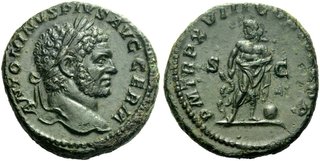This record is provided by CoinArchives, a database of numismatic auction catalogs.
Important copyright information:
The data below is presented by permission of the copyright holder(s). Reproduction is allowed only by authorization from Numismatica Ars Classica.
Important copyright information:
The data below is presented by permission of the copyright holder(s). Reproduction is allowed only by authorization from Numismatica Ars Classica.
| Numismatica Ars Classica > Auction 80 | Auction date: 20 October 2014 |
| Lot number: 133 | |
| Lot description: The Roman Empire Caracalla, 198 – 217 As 215, Æ 10.95 g. ANTONINVS PIVS AVG GERM Laureate head r. Rev. P M TR P XVIII COS IIII P P / S – C. Asclepius of Pergamum in himation, chest bare, standing r., head turned l., holding with his r. hand serpent-wreathed wand, which rests against his r. side, his l. in fold of robe; at his feet, omphalos. C 309. BMC 294 var. (draped and cuirassed bust). Hill, Severi 34, 1453. RIC 553a. Of excellent style and with a fine green patina, about extremely fine / extremely fine Ex Tkalec & Rauch 25-26 April 1989, 342 and M&M 92, 2002, 137 sales. Returning from the military expedition against the Germani, Caracalla was physically exhausted. He was haunted by nightmares in which he was persecuted by his murdered brother Geta, holding a bloody sword in his hands (Cassius Dio LXXVIII, 15, 2-7). The emperor hoped for healing from Asclepius and on his travels he visited several sanctuaries of the god. On the occasion of his journey for the military campaign against the Parthians in the East, Caracalla visited Pergamum, which in the 3rd century AD was one of the well known and popular sanctuaries of the god of healing. The patients were cured by incubation, i.e. hypnotherapy, a method which was especially successful for psychosomatic diseases. Also Caracalla had the feeling that he could sense the amelioration of his problems by the blessing of Asclepius. Therefore he was thankful to the city of Pergamum and to its patron and so he granted it special privileges; he put the healing god on the reverse of his imperial coinage, with very particular iconography of the Pergamene Asclepius: he is propped up on the serpent entwined staff, he puts his left hand into the fold of the himation and at his feet the omphalos. Another issue depicts the same Asclepius with his pergamene associate Telesphoros, a small figure wrapped up in a large hood which was worn by the patients during the hypnotherapy; Telesphorus was Asclepius' envoy bringing an end to the suffering, i.e. recovery or death. See U. Kampmann, Asklepios mit Omphalos in der römischen Reichsprägung. Zu einem Beispiel der Beeinflussung der Reichsprägung durch Lokalmünzen, JNG 42/43 (1992/93), 39-48 and Johannes Nollé, Die Krankheit des Kaisers Caracalla, MünzenRevue 28/5 (1996), 26-33. Estimate: 1250 CHF |  |


